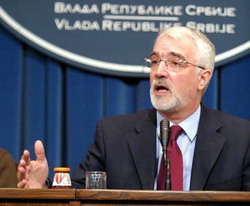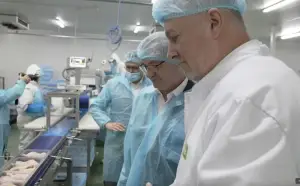Q:
A:
Economic Policy of the Serbian government in 2005
Belgrade,
17 December 2004
Serbian Deputy Prime Minister Miroljub Labus said in an article he wrote with the title "Economic Policy of the Serbian Government in 2005", published in the latest edition of the E-Magazine, that the Serbian government will continue to implement economic policy and reforms aimed at securing macroeconomic stability, safe business operations and sustainable economic growth. The Serbian government's official web site brings the full text.
The first three years of transition in Serbia were marked by generally favourable economic results, especially the achieving of macroeconomic stability through significant reduction of the inflation rate, and the pronounced growth of real GDP. Notably significant progress was achieved in relations with international financial institutions, foreign creditors and investors, which resulted in a significant debt write-off, and a relatively high capital inflow. Negative tendencies were recorded only in the field of foreign trade, where imports were three times higher than exports, and the balance payments deficit made up approximately 13 percent of GDP. In the next year, the deficit can be reduced only to 12 percent, not more, it is said in the text.
Speaking about 2004, macroeconomic flows have been marked by significant economic recovery, first and foremost of industry, agriculture, telecommunications and civil engineering industry. The expected GDP growth is around 8 percent.
In 2005, the Serbian government will continue to implement economic policy and reforms aimed at securing macroeconomic stability, safe business operations and sustainable economic growth. The main goal of the economic policy will be to achieve economic growth between 4 and 5 percent, with an inflation rate under 10 percent.
Monetary policy measures?
In 2005, the government will continue with the monetary policy of binding primary money and money supply to net currency assets flows, and with the policy of managing a flexible exchange rate of the dinar. The price stability will also be a priority, and the exchange rate will be formed according to supply and demand on the foreign exchange market, taking care to maintain a sustainable balance of payments position of the country.
Fiscal policy measures?
In the field of public revenues, the main goal for the next period is to reduce taxes, especially tax on income of employees, and to increase taxes on production factors and property, to expand tax base and increase volume of income. The value added tax (VAT) will come into force on January 1, 2005, and it is expected that it will markedly increase budget revenues and that the collection of funds in this way will be carried out with less distortions in the economy. The introduction of the VAT is a significant measure in the fight against grey economy and unfair competition. Also, the tax on financial transactions will be abolished on January 1, which is expected to markedly reduce costs of payment operations.
Speaking about public expenditures, the aim is to gradually reduce share of public expenditures and deficit in GDP. The main change in the structure of public expenditure is an increase of funds for social security, education, health care and general public services.
The main problem in Serbia's public finance is the financing of pensions. A deficit in the pension funds makes up approximately 6 percent of GDP on an annual level, which is covered by direct transfers from the budget. Such a system is not sustainable in the long run, so reform of the pension system must be continued next year. The goal of the reform of pension insurance is to establish a financially sustainable system, based on two pillars: compulsory insurance based on generation solidarity, and voluntary insurance based on personal capitalised savings. These funds will represent a new source of long-term financing, which is a necessary precondition for sustainable economic growth, and will also contribute to development of the financial market. Structural Reforms?
The next year will be the year of structural reforms, and the government is resolute in its intention to go on with the processes of privatisation and restructuring of companies. The plan stipulates that the process of auction privatisation of small and medium sized companies is completed within the shortest time and to keep on with selling large companies by means of tender to strategic partners. At the same time, the privatisation of insolvent companies through bankruptcy procedure will be going on. Also, conditions will be made to offer the shares from the Share Fund on the market.
The restructuring of large socially and state owned companies will be speeded up, in a business and financial sense, with the aim of preparing those companies through reorganisation status changes, and by solving the problem of unemployed and obligations of these companies arising from the value of their assets. The restructuring programmes of large companies will be followed by development programmes of small and medium sized enterprises, with the expectation that they will employ labour surplus and capacities of large companies.
The government will conduct an active policy of stimulating the development of small and medium sized enterprises with the aim of increasing the number of such enterprises, and thus, creating conditions for opening new jobs and overall economic growth. The interventions by the state will be directed to improving the business environment and building a market of non-financial services for the development of business management of SMEs and entrepreneurs. The state will remove the barriers for opening new jobs in privately owned SMEs, as well as barriers for strengthening the completion and creating equal conditions for all economic subjects.
As for the financial sector, the changes of the existing and a new regulative connected with the functioning of the financial market will be passed. That includes changes and amendments to the Law on Securities as well as adopting the law on insurance funds. Stimulative conditions will be created for citizens and institutional investors in order to get involved more in the trade of long term securities. State securities will play a significant role in that process, considering the degree of safety for investors.
The reform of the banking sector will continue toward an accelerated privatisation of banks that are mainly state owned. The Bank Rehabilitation Agency will conduct a plan of sale of these banks, and based on that plan, tenders for their sale will be called.
In the field of energy and transport, a long-term development strategy will be adopted, and a new judiciary and regulatory framework will be established, which will create conditions for speeding up the restructuring process of public companies in these fields. As for agriculture, the government will maintain its policy with the basic aim to create a competitive agriculture sector in order to provide stability on the market and export growth. The measures will be directed to improving the production structure toward growing industrial crops, vegetables, fruit and vine, as well as additionally stimulating the export production.
It is important to stress that a textile agreement has been reached with the EU, which will provide textile makers in our country access on the EU market with no quotas and customs fees. Also, negotiations are underway with the EU on setting export quotas for sugar, which is one of Serbia’s most important export products.
Public debt?
The basic goals of the public debt policy are reducing the share of domestic and foreign public debt in comparison with GDP and providing conditions for undisturbed servicing of obligations of the state to domestic and foreign creditors. Providing fiscal sustainability in the next medium term period will mean keeping the share in the domestic and foreign public debt below 60 percent of GDP, now standing at 55.3 percent. After regulating the remaining debt to the creditors of the Paris Club, the share will total 49.5 percent. However, even such reduced public debt will call for serious fiscal effort in order to service the interests for foreign loans and keeping external liquidity. Also, the process of regulating the debts made by debtors from Kosovo-Metohija is expected to start.
Speaking about 2004, macroeconomic flows have been marked by significant economic recovery, first and foremost of industry, agriculture, telecommunications and civil engineering industry. The expected GDP growth is around 8 percent.
In 2005, the Serbian government will continue to implement economic policy and reforms aimed at securing macroeconomic stability, safe business operations and sustainable economic growth. The main goal of the economic policy will be to achieve economic growth between 4 and 5 percent, with an inflation rate under 10 percent.
Monetary policy measures?
In 2005, the government will continue with the monetary policy of binding primary money and money supply to net currency assets flows, and with the policy of managing a flexible exchange rate of the dinar. The price stability will also be a priority, and the exchange rate will be formed according to supply and demand on the foreign exchange market, taking care to maintain a sustainable balance of payments position of the country.
Fiscal policy measures?
In the field of public revenues, the main goal for the next period is to reduce taxes, especially tax on income of employees, and to increase taxes on production factors and property, to expand tax base and increase volume of income. The value added tax (VAT) will come into force on January 1, 2005, and it is expected that it will markedly increase budget revenues and that the collection of funds in this way will be carried out with less distortions in the economy. The introduction of the VAT is a significant measure in the fight against grey economy and unfair competition. Also, the tax on financial transactions will be abolished on January 1, which is expected to markedly reduce costs of payment operations.
Speaking about public expenditures, the aim is to gradually reduce share of public expenditures and deficit in GDP. The main change in the structure of public expenditure is an increase of funds for social security, education, health care and general public services.
The main problem in Serbia's public finance is the financing of pensions. A deficit in the pension funds makes up approximately 6 percent of GDP on an annual level, which is covered by direct transfers from the budget. Such a system is not sustainable in the long run, so reform of the pension system must be continued next year. The goal of the reform of pension insurance is to establish a financially sustainable system, based on two pillars: compulsory insurance based on generation solidarity, and voluntary insurance based on personal capitalised savings. These funds will represent a new source of long-term financing, which is a necessary precondition for sustainable economic growth, and will also contribute to development of the financial market. Structural Reforms?
The next year will be the year of structural reforms, and the government is resolute in its intention to go on with the processes of privatisation and restructuring of companies. The plan stipulates that the process of auction privatisation of small and medium sized companies is completed within the shortest time and to keep on with selling large companies by means of tender to strategic partners. At the same time, the privatisation of insolvent companies through bankruptcy procedure will be going on. Also, conditions will be made to offer the shares from the Share Fund on the market.
The restructuring of large socially and state owned companies will be speeded up, in a business and financial sense, with the aim of preparing those companies through reorganisation status changes, and by solving the problem of unemployed and obligations of these companies arising from the value of their assets. The restructuring programmes of large companies will be followed by development programmes of small and medium sized enterprises, with the expectation that they will employ labour surplus and capacities of large companies.
The government will conduct an active policy of stimulating the development of small and medium sized enterprises with the aim of increasing the number of such enterprises, and thus, creating conditions for opening new jobs and overall economic growth. The interventions by the state will be directed to improving the business environment and building a market of non-financial services for the development of business management of SMEs and entrepreneurs. The state will remove the barriers for opening new jobs in privately owned SMEs, as well as barriers for strengthening the completion and creating equal conditions for all economic subjects.
As for the financial sector, the changes of the existing and a new regulative connected with the functioning of the financial market will be passed. That includes changes and amendments to the Law on Securities as well as adopting the law on insurance funds. Stimulative conditions will be created for citizens and institutional investors in order to get involved more in the trade of long term securities. State securities will play a significant role in that process, considering the degree of safety for investors.
The reform of the banking sector will continue toward an accelerated privatisation of banks that are mainly state owned. The Bank Rehabilitation Agency will conduct a plan of sale of these banks, and based on that plan, tenders for their sale will be called.
In the field of energy and transport, a long-term development strategy will be adopted, and a new judiciary and regulatory framework will be established, which will create conditions for speeding up the restructuring process of public companies in these fields. As for agriculture, the government will maintain its policy with the basic aim to create a competitive agriculture sector in order to provide stability on the market and export growth. The measures will be directed to improving the production structure toward growing industrial crops, vegetables, fruit and vine, as well as additionally stimulating the export production.
It is important to stress that a textile agreement has been reached with the EU, which will provide textile makers in our country access on the EU market with no quotas and customs fees. Also, negotiations are underway with the EU on setting export quotas for sugar, which is one of Serbia’s most important export products.
Public debt?
The basic goals of the public debt policy are reducing the share of domestic and foreign public debt in comparison with GDP and providing conditions for undisturbed servicing of obligations of the state to domestic and foreign creditors. Providing fiscal sustainability in the next medium term period will mean keeping the share in the domestic and foreign public debt below 60 percent of GDP, now standing at 55.3 percent. After regulating the remaining debt to the creditors of the Paris Club, the share will total 49.5 percent. However, even such reduced public debt will call for serious fiscal effort in order to service the interests for foreign loans and keeping external liquidity. Also, the process of regulating the debts made by debtors from Kosovo-Metohija is expected to start.











